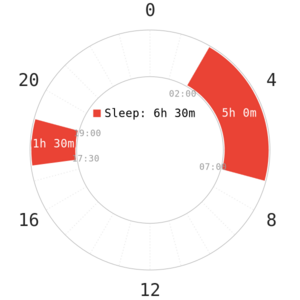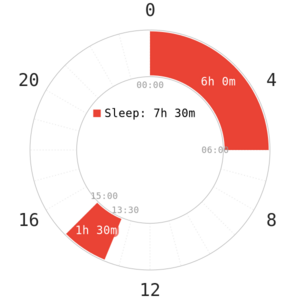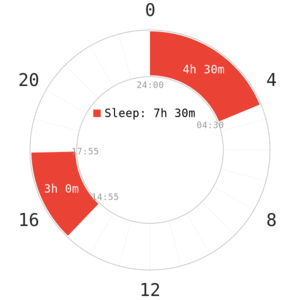Siesta/ru: Difference between revisions
No edit summary |
Updating to match new version of source page |
||
| (One intermediate revision by the same user not shown) | |||
| Line 1: | Line 1: | ||
{{TNT|Siesta}} | {{TNT|Siesta}} | ||
Сиеста - [[Special:MyLanguage/biphasic|бифазный график]], который состоит из длинного [[Special:MyLanguage/Cores|ядра]] ночью и более короткого днем. | Сиеста - [[Special:MyLanguage/biphasic|бифазный график]], который состоит из длинного [[Special:MyLanguage/Cores|ядра]] ночью и более короткого днем. | ||
<span id="Origin"></span> | |||
== Происхождение == | == Происхождение == | ||
На протяжении всей истории Сиеста была очень распространенным режимом сна в Испании и многих других странах по всему миру. Тем не менее, вероятнее всего, их расписание не сокращало сон и было более гибким. | На протяжении всей истории Сиеста была очень распространенным режимом сна в Испании и многих других странах по всему миру. Тем не менее, вероятнее всего, их расписание не сокращало сон и было более гибким. | ||
<span id="Mechanism"></span> | |||
== Механизм == | == Механизм == | ||
| Line 14: | Line 14: | ||
Однако, в отличие от большинства стандартных расписаний, ядра которых кратны 90-минутному циклу сна, стандартный вариант Сиесты содержит 5-часовое ядро, потому что последние 30 минут, вероятно, содержат дополнительный [[wikipedia:Rapid_eye_movement_sleep|REM]]. Исходя из типичной структуры сна человека, ожидается, что [[wikipedia:Slow-wave_sleep|SWS]] будет почти, если не полностью, покрыт за первые 3 полных цикла сна (4,5 часа). При [[Special:MyLanguage/monophasic|монофазном]] сне циклы REM часто длиннее 90 минут, поэтому дополнительные 30 минут сна также могут помочь завершить их. | Однако, в отличие от большинства стандартных расписаний, ядра которых кратны 90-минутному циклу сна, стандартный вариант Сиесты содержит 5-часовое ядро, потому что последние 30 минут, вероятно, содержат дополнительный [[wikipedia:Rapid_eye_movement_sleep|REM]]. Исходя из типичной структуры сна человека, ожидается, что [[wikipedia:Slow-wave_sleep|SWS]] будет почти, если не полностью, покрыт за первые 3 полных цикла сна (4,5 часа). При [[Special:MyLanguage/monophasic|монофазном]] сне циклы REM часто длиннее 90 минут, поэтому дополнительные 30 минут сна также могут помочь завершить их. | ||
<span id="Adaptation"></span> | |||
== Адаптация== | == Адаптация== | ||
Вполне вероятно, что во время адаптации пробуждение после ночного ядра может быть трудным, в основном если оно происходит во время SWS или REM, когда перераспределение стадий сна еще не завершено. Со временем пробуждение станет освежающим. Обычно сообщается, что дневное ядро проще в управлении. Однако для тех, кто не привык так долго спать днем, это может потребовать обучения и адаптации. | Вполне вероятно, что во время адаптации пробуждение после ночного ядра может быть трудным, в основном если оно происходит во время SWS или REM, когда перераспределение стадий сна еще не завершено. Со временем пробуждение станет освежающим. Обычно сообщается, что дневное ядро проще в управлении. Однако для тех, кто не привык так долго спать днем, это может потребовать обучения и адаптации. | ||
<span id="Difficulty"></span> | |||
== Сложность == | == Сложность == | ||
За прошедшие годы Сиеста добилась больших успехов, большинство из которых принадлежали не сокращающей сон версии. Однако стандартная сокращающая сон версия менее успешна из-за необходимости адаптации к сокращению сна. В целом адаптация относительно мягкая. В некоторых случаях Сиеста может быть проще, чем E1. При хорошей системе будильников и управлении временем, большинство людей могут адаптироваться к Сиесте. | За прошедшие годы Сиеста добилась больших успехов, большинство из которых принадлежали не сокращающей сон версии. Однако стандартная сокращающая сон версия менее успешна из-за необходимости адаптации к сокращению сна. В целом адаптация относительно мягкая. В некоторых случаях Сиеста может быть проще, чем E1. При хорошей системе будильников и управлении временем, большинство людей могут адаптироваться к Сиесте. | ||
<span id="Lifestyle_considerations"></span> | |||
== Образ жизни == | == Образ жизни == | ||
| Line 30: | Line 33: | ||
С другой стороны, Сиеста также известна как адаптация человека к болезням<ref name="b" /> (в том числе хроническим инфекционным заболеваниям). Люди обычно спят больше в тяжелом состоянии, и часто это напоминает расширенные варианты Сиесты, где оба ядра намного дольше, чем обычно, чтобы обеспечить умственное и физическое восстановление после болезни. | С другой стороны, Сиеста также известна как адаптация человека к болезням<ref name="b" /> (в том числе хроническим инфекционным заболеваниям). Люди обычно спят больше в тяжелом состоянии, и часто это напоминает расширенные варианты Сиесты, где оба ядра намного дольше, чем обычно, чтобы обеспечить умственное и физическое восстановление после болезни. | ||
<span id=" | |||
<span id="Variants"></span> | |||
== Варианты == | == Варианты == | ||
За прошедшие годы многие полифазники адаптировались к нестандартным вариантам Сиесты. Время начала ядер тоже варьировалось. Новичкам также следует изучить различия в альтернативных вариантах расписания, прежде чем выбрать желаемый вариант. | За прошедшие годы многие полифазники адаптировались к нестандартным вариантам Сиесты. Время начала ядер тоже варьировалось. Новичкам также следует изучить различия в альтернативных вариантах расписания, прежде чем выбрать желаемый вариант. | ||
<span id="Late_core"></span> | |||
=== Позднее ядро === | === Позднее ядро === | ||
| Line 42: | Line 49: | ||
Несмотря на преимущества, известно, что адаптация к этому варианту сложнее, чем стандартная, потому что смещение ночного ядра с пика SWS потребует управления питанием, упражнениями и освещением для обеспечения достаточного количества SWS. (См. также: [[Special:MyLanguage/dark period|темный период]]) Тем, у кого более низкая потребность в SWS, вероятно, будет проще. Короткое ядро находится гораздо позже днем или ранним вечером, возможно даже в 19:30. Однако даже в этом случае оно может быть неудобным для социальной жизни. | Несмотря на преимущества, известно, что адаптация к этому варианту сложнее, чем стандартная, потому что смещение ночного ядра с пика SWS потребует управления питанием, упражнениями и освещением для обеспечения достаточного количества SWS. (См. также: [[Special:MyLanguage/dark period|темный период]]) Тем, у кого более низкая потребность в SWS, вероятно, будет проще. Короткое ядро находится гораздо позже днем или ранним вечером, возможно даже в 19:30. Однако даже в этом случае оно может быть неудобным для социальной жизни. | ||
<span id="Slightly_modified_core_length"></span> | |||
=== Слегка измененная длина ядра === | === Слегка измененная длина ядра === | ||
| Line 49: | Line 57: | ||
Второй вариант Сиесты с ночным 4,5-часовым ядром будет соответствовать правилу кратности 90-минутному циклу. Однако до сих пор она имела гораздо меньший успех, чем стандартная версия. Люди с немного более низкой потребностью во сне (например, 7 часов монофазного сна) могут адаптироваться к этому варианту. Обратите внимание, что после адаптации к стандартному варианту Сиесты, ночное ядро может иногда естественным образом сокращаться до 4,5 часов, но это происходит не очень часто. | Второй вариант Сиесты с ночным 4,5-часовым ядром будет соответствовать правилу кратности 90-минутному циклу. Однако до сих пор она имела гораздо меньший успех, чем стандартная версия. Люди с немного более низкой потребностью во сне (например, 7 часов монофазного сна) могут адаптироваться к этому варианту. Обратите внимание, что после адаптации к стандартному варианту Сиесты, ночное ядро может иногда естественным образом сокращаться до 4,5 часов, но это происходит не очень часто. | ||
<span id="Night_core_extension"></span> | |||
=== Продление ночного ядра === | === Продление ночного ядра === | ||
| Line 54: | Line 63: | ||
Этот вариант также пользуется большим успехом, в основном у людей, ведущих активный образ жизни или у тех, кто продолжает расти. Адаптация намного проще стандартной, а расширенное ночное ядро следует правилу 90-минутного цикла. Это все еще дает некоторое сокращение сна для людей с высокими монофазными потребностями. Ночное ядро может быть расширено и в большей степени, позволяя совсем не сокращать сон по сравнению с монофазным. Примером может быть 6,5-7 часов ночного сна и 90 минут дневного сна для человека с монофазной потребностью ~8-9 часов. Подобный вариант обычно намного более гибкий, даже во время адаптации. | Этот вариант также пользуется большим успехом, в основном у людей, ведущих активный образ жизни или у тех, кто продолжает расти. Адаптация намного проще стандартной, а расширенное ночное ядро следует правилу 90-минутного цикла. Это все еще дает некоторое сокращение сна для людей с высокими монофазными потребностями. Ночное ядро может быть расширено и в большей степени, позволяя совсем не сокращать сон по сравнению с монофазным. Примером может быть 6,5-7 часов ночного сна и 90 минут дневного сна для человека с монофазной потребностью ~8-9 часов. Подобный вариант обычно намного более гибкий, даже во время адаптации. | ||
<span id="Day_core_extension"></span> | |||
=== Продление дневного ядра === | === Продление дневного ядра === | ||
| Line 59: | Line 69: | ||
Этот вариант, напоминающий [[Special:MyLanguage/Segmented|Сегментированный сон]], также имеет некоторый успех. Он особенно распространен среди тех, кто работает в вечернюю смену. [[Special:MyLanguage/dark period|Темный период]] должен начинаться за 1.5-3 часа до ночного ядра и продолжаться до ~1.5-2 часов после ночного ядра, чтобы стабилизировать циркадный ритм. Для этого варианта может потребоваться дополнительное [[Special:MyLanguage/circadian management|управление циркадным ритмом]], поскольку дневное ядро может заставить организм принять его за ночной сон. | Этот вариант, напоминающий [[Special:MyLanguage/Segmented|Сегментированный сон]], также имеет некоторый успех. Он особенно распространен среди тех, кто работает в вечернюю смену. [[Special:MyLanguage/dark period|Темный период]] должен начинаться за 1.5-3 часа до ночного ядра и продолжаться до ~1.5-2 часов после ночного ядра, чтобы стабилизировать циркадный ритм. Для этого варианта может потребоваться дополнительное [[Special:MyLanguage/circadian management|управление циркадным ритмом]], поскольку дневное ядро может заставить организм принять его за ночной сон. | ||
<span id="References"></span> | |||
==Примечания== | ==Примечания== | ||
Latest revision as of 00:47, 6 April 2025
| Сиеста | |
|---|---|
| ссылка на napchart
Legend
| |
| Время сна | 6 часов 30 минут |
| Предложено | Нет, используется людьми на протяжении всей истории. |
| Сложность | Умеренная |
| Особенности | 1 длинное ядро, 1 короткое ядро днем |
Сиеста - бифазный график, который состоит из длинного ядра ночью и более короткого днем.
Происхождение
На протяжении всей истории Сиеста была очень распространенным режимом сна в Испании и многих других странах по всему миру. Тем не менее, вероятнее всего, их расписание не сокращало сон и было более гибким.
Механизм
Как и в случае с E1, механизм Сиесты основан на циркадном спаде около полудня. В отличие от E1, дневное ядро содержит полный цикл сна, который намного лучше восстанавливает силы, чем короткий нэп. Более продолжительный дневной сон также позволяет сократить ночной сон. Обычно промежуток бодрствования между ночным и дневным ядрами может составлять от 6 до 9 часов.
Однако, в отличие от большинства стандартных расписаний, ядра которых кратны 90-минутному циклу сна, стандартный вариант Сиесты содержит 5-часовое ядро, потому что последние 30 минут, вероятно, содержат дополнительный REM. Исходя из типичной структуры сна человека, ожидается, что SWS будет почти, если не полностью, покрыт за первые 3 полных цикла сна (4,5 часа). При монофазном сне циклы REM часто длиннее 90 минут, поэтому дополнительные 30 минут сна также могут помочь завершить их.
Адаптация
Вполне вероятно, что во время адаптации пробуждение после ночного ядра может быть трудным, в основном если оно происходит во время SWS или REM, когда перераспределение стадий сна еще не завершено. Со временем пробуждение станет освежающим. Обычно сообщается, что дневное ядро проще в управлении. Однако для тех, кто не привык так долго спать днем, это может потребовать обучения и адаптации.
Сложность
За прошедшие годы Сиеста добилась больших успехов, большинство из которых принадлежали не сокращающей сон версии. Однако стандартная сокращающая сон версия менее успешна из-за необходимости адаптации к сокращению сна. В целом адаптация относительно мягкая. В некоторых случаях Сиеста может быть проще, чем E1. При хорошей системе будильников и управлении временем, большинство людей могут адаптироваться к Сиесте.
Образ жизни
Сиеста в целом является популярным режимом, хотя и в меньшей степени, чем E1. Во-первых, дневное ядро труднее расположить днем по сравнению с 20-минутным нэпом на E1. Другая проблема заключается в том, что время приема пищи необходимо планировать либо сразу после дневного ядра, либо за несколько часов до него, чтобы обеспечить его качество. Однако при расширенной версии свобода в планировании приема пищи возрастает, так как общее время сна больше. После адаптации график можно сделать гибким, сдвигая ядра на немного более раннее или позднее время.
Сиеста (особенно расширенная) хорошо подходит спортсменам, выполняющим интенсивные упражнения. Роджер Федерер и Усэйн Болт являются примером тому и, как известно, обычно долго спят днем. Дневное ядро обеспечивает восстановление после интенсивной тренировки, предоставляя дополнительное время для сна в соответствии с повышенной потребностью в SWS. Было показано, что после тренировки на выносливость давление SWS повышается, и дневное ядро позволяет получить SWS[1]. Считается, что появление SWS во время длительного дневного сна вызывает высвобождение гормона роста (GH), который регулирует уровень глюкозы и запасы гликогена, которые часто истощаются во время интенсивных тренировок.
С другой стороны, Сиеста также известна как адаптация человека к болезням[2] (в том числе хроническим инфекционным заболеваниям). Люди обычно спят больше в тяжелом состоянии, и часто это напоминает расширенные варианты Сиесты, где оба ядра намного дольше, чем обычно, чтобы обеспечить умственное и физическое восстановление после болезни.
Варианты
За прошедшие годы многие полифазники адаптировались к нестандартным вариантам Сиесты. Время начала ядер тоже варьировалось. Новичкам также следует изучить различия в альтернативных вариантах расписания, прежде чем выбрать желаемый вариант.
Позднее ядро

За прошедшие годы было зафиксировано несколько успешных адаптаций к этому варианту. Основная его идея - обеспечить более длительный перерыв в бодрствовании днем при стандартном графике работы или учебы. Полифазник спит ночью, идет на работу и восстанавливает силы после нее с помощью дневного ядра. К достоинствам этого расписания можно отнести бодрствование в вечерние и ночные часы. По этой причине этот вариант подходит для многих.
Несмотря на преимущества, известно, что адаптация к этому варианту сложнее, чем стандартная, потому что смещение ночного ядра с пика SWS потребует управления питанием, упражнениями и освещением для обеспечения достаточного количества SWS. (См. также: темный период) Тем, у кого более низкая потребность в SWS, вероятно, будет проще. Короткое ядро находится гораздо позже днем или ранним вечером, возможно даже в 19:30. Однако даже в этом случае оно может быть неудобным для социальной жизни.
Слегка измененная длина ядра

Один человек адаптировался к ночному ядру длительностью 5,5 часов. Поскольку такая длина ядра увеличивает вероятность пробуждения SWS, она может быть довольно трудной. Однако это может иметь преимущества для тех, у кого более высокая потребность в REM. Дополнительные 30 минут также могут позволить увеличить промежуток бодрствования между ночным и дневным ядрами.
Второй вариант Сиесты с ночным 4,5-часовым ядром будет соответствовать правилу кратности 90-минутному циклу. Однако до сих пор она имела гораздо меньший успех, чем стандартная версия. Люди с немного более низкой потребностью во сне (например, 7 часов монофазного сна) могут адаптироваться к этому варианту. Обратите внимание, что после адаптации к стандартному варианту Сиесты, ночное ядро может иногда естественным образом сокращаться до 4,5 часов, но это происходит не очень часто.
Продление ночного ядра

Этот вариант также пользуется большим успехом, в основном у людей, ведущих активный образ жизни или у тех, кто продолжает расти. Адаптация намного проще стандартной, а расширенное ночное ядро следует правилу 90-минутного цикла. Это все еще дает некоторое сокращение сна для людей с высокими монофазными потребностями. Ночное ядро может быть расширено и в большей степени, позволяя совсем не сокращать сон по сравнению с монофазным. Примером может быть 6,5-7 часов ночного сна и 90 минут дневного сна для человека с монофазной потребностью ~8-9 часов. Подобный вариант обычно намного более гибкий, даже во время адаптации.
Продление дневного ядра

Этот вариант, напоминающий Сегментированный сон, также имеет некоторый успех. Он особенно распространен среди тех, кто работает в вечернюю смену. Темный период должен начинаться за 1.5-3 часа до ночного ядра и продолжаться до ~1.5-2 часов после ночного ядра, чтобы стабилизировать циркадный ритм. Для этого варианта может потребоваться дополнительное управление циркадным ритмом, поскольку дневное ядро может заставить организм принять его за ночной сон.
Примечания
- ↑ Davies DJ, Graham KS, Chow CM (2010). "The effect of prior endurance training on nap sleep patterns". International Journal of Sports Physiology and Performance. 5 (1): 87–97. doi:10.1123/ijspp.5.1.87.
- ↑ Barone TL (2000). "Is the siesta an adaptation to disease? : A cross-cultural examination". Human Nature. 11 (3): 233–258. doi:10.1007/s12110-000-1012-4.
